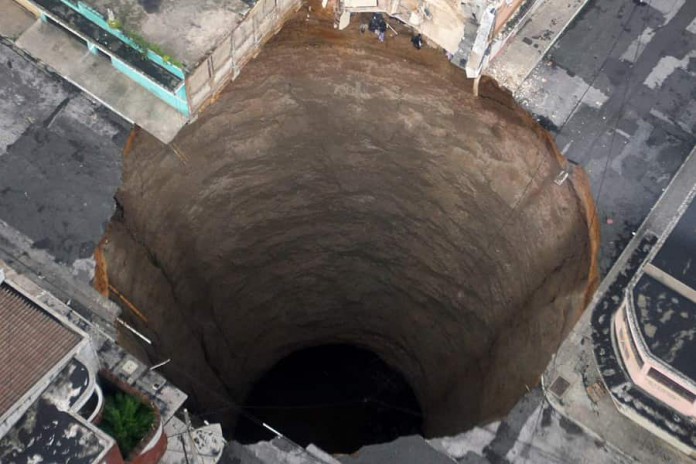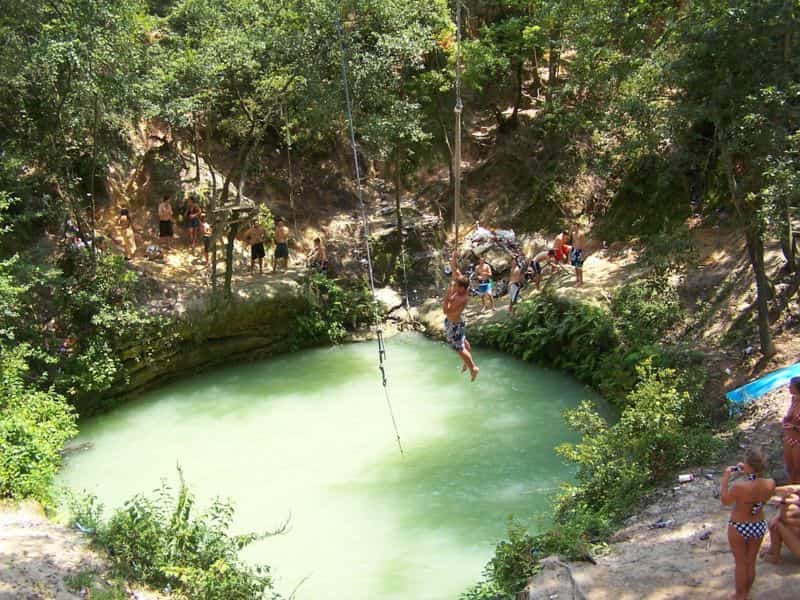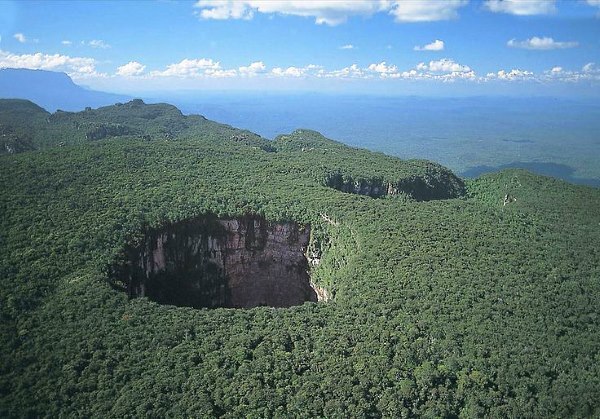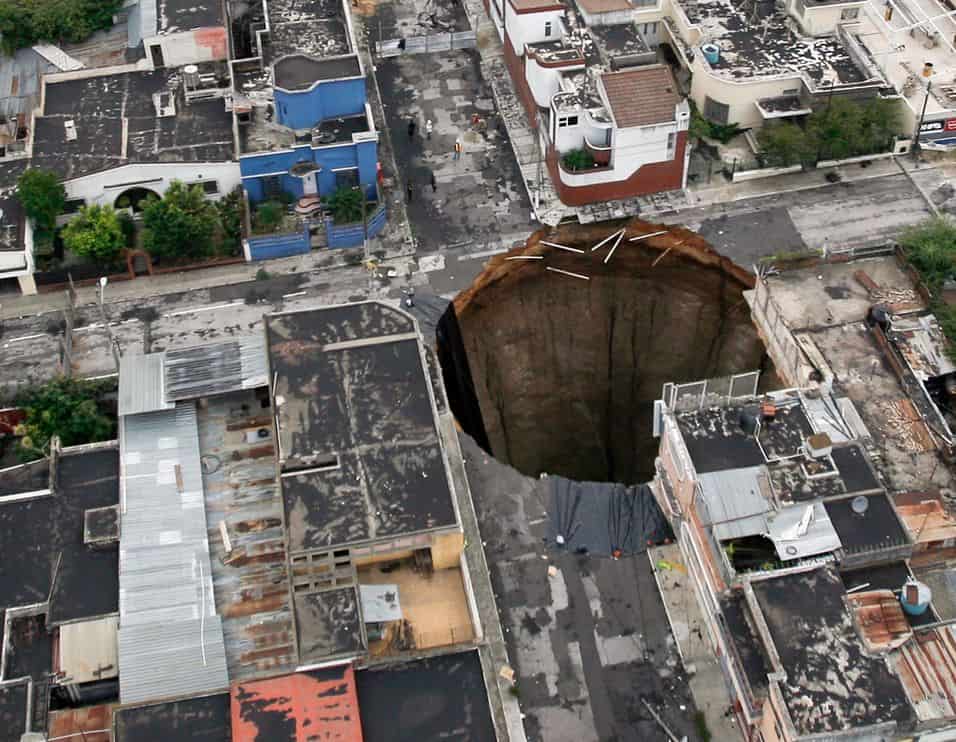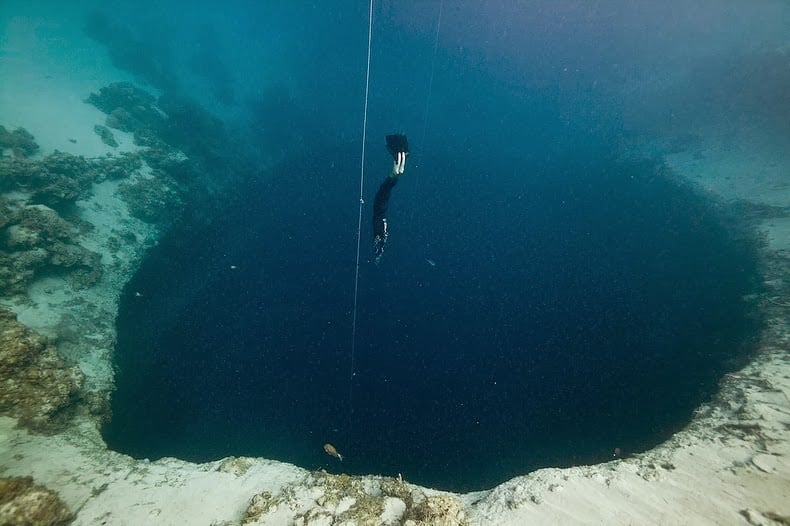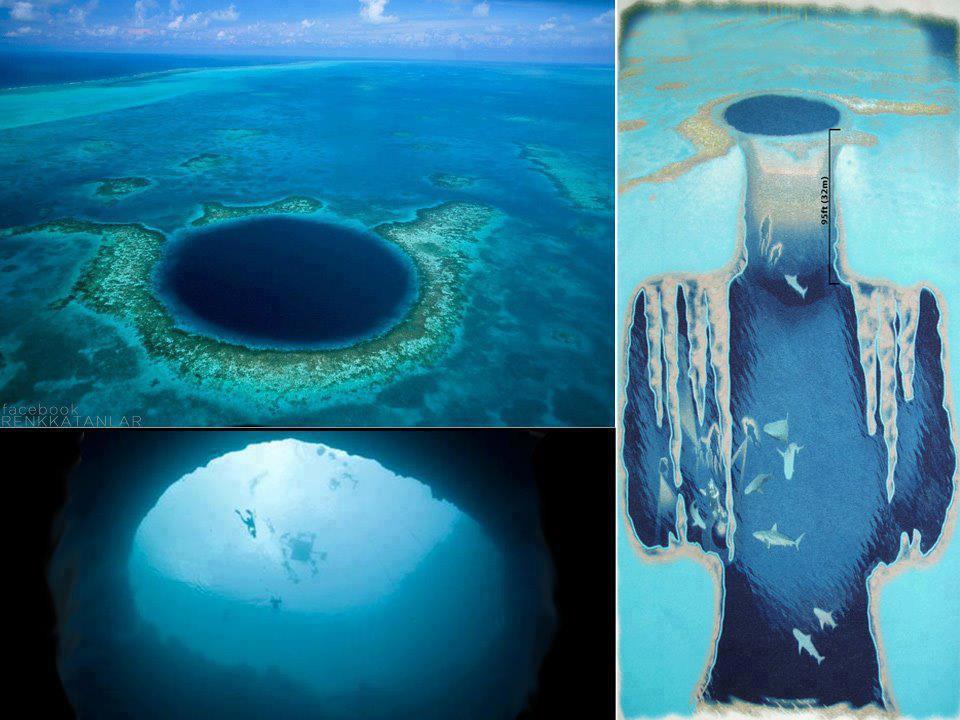A sinkhole is a natural depression or hole in the Earth’s surface which may have various causes. Sinkholes may vary in size from 1 to 600 m (3.3 to 2,000 ft) both in diameter and depth, and vary in form. Sinkholes may be formed gradually or suddenly, and are found worldwide.Here Given Top 10 Sinkholes in the world please check it out:
10. The Devil’s toilet bowl (Devil’s Hole), Florida
A sinkhole near Hawthorne, Florida. It is hidden from the surroundings by vegetation but visitors that find it enjoy this sinkhole that is filled by a small lake and jump in for a swim.
The Devil’s hole (sometimes referred to as the “Devil’s Toilet Bowl” by the locals) is a sinkhole that is actually enjoyed by visitors.  The thick vegetation near it hide it from the surroundings.  Once there, sinkhole which converted into a minilake has a rope swing and two platforms from which you can jump in.
This particular swimming hole/party place is about 200 feet from the surface level down the the water. The water itself is is over 90 feet deep.
Take S-20 from Gainesville towards Hawthorne. Look for route CR-21. Turn left onto Lake Galilee Dr, about 1.8 miles from the CR-21 intersection. Travel about 150 yards and take a dirt road to the left, just past the first group of mobile homes. The sink will be a little under .5 miles on the left hand side.
This can be a very difficult site in which to enter and egress due to the steep sides. The sink is about 60 feet in diameter with the water level about 50 from the top of the sink. Water depth is about 80 feet, though it can be tannic at times. There is an old ladder on site, but make sure to inspect the anchors. It is best to bring a surface buddy to watch your stuff and provide assistance.
9.Zacatón – Tamaulipas, Mexico
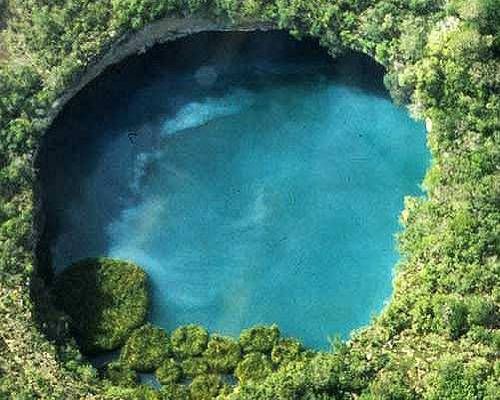
Zacatón, in the Mexican state of Tamaulipas, is the world’s deepest identified water-filled sinkhole, descending to an incredible 1,112 feet (339 meters). According to Dr. Marcus Gary, a hydrogeologist who has been studying the sinkhole, the massive shaft was created by volcanic activity far below the surface, which would have acidified the water – in turn gradually dissolving the rock above. Progressive collapse then led to a deeper and deeper vertical cave.
A highly unusual feature of Zacatón is the number of small islands floating freely on the surface of the water. These were created by precipitated calcium carbonate and are covered with a thick mat of grass known as “zacate†in Mexico. The islands are also shifted around the lake by the wind. Interesting microorganisms have been discovered on the walls of the sinkhole as well, and analysis confirms that there are species previously unknown to science.
8.Xiaozhai Tiankeng – Chongqing, China
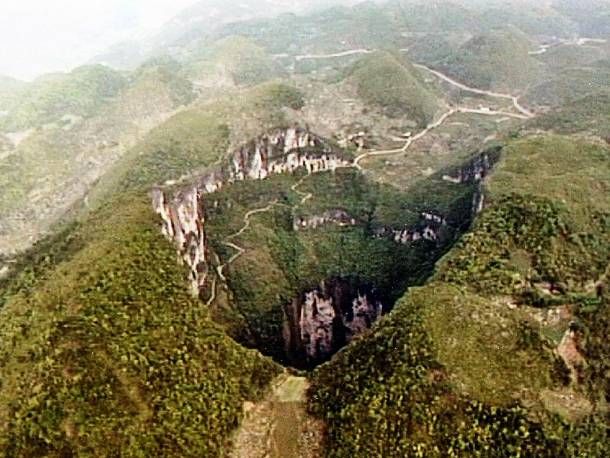
Xiaozhai Tiankeng, also referred to as the “Heavenly Pit,†is a double-nested sinkhole in the Chinese district of Chongqing. This incredible cavity in the Earth’s crust is the largest sinkhole in the world. The combined depth of Xiaozhai Tiankeng’s nested holes is a whopping 2,172 feet (662 meters), and the yawning depression is 1,762 feet (537 meters) wide.
As with several of the other sinkholes on this list, Xiaozhai Tiankeng was formed after a subterranean river eroded a giant cavern out of the area’s limestone rock. When the roof of this massive cave collapsed, the sinkhole was born. Xiaozhai Tiankeng has significant tourism appeal in China, and it sometimes attracts BASE jumpers as well as people hoping to catch a glimpse of the rare fauna and flora. Exotically beautiful clouded leopards and 1,285 different types of plants have been discovered in Xiaozhai Tiankeng.
7.Sima Humboldt (Sima Major), Venezuela
An enormous sinkhole located on the summit of a plateau in Bolivar state, Venezuela. It has a depth of 314 meters (1,030Â ft) and a width of 352Â meters (1,155Â ft) in the upper rim and 502Â meters (1,647Â ft) below.
6.Sima de las Cotorras – Chiapas, Mexico
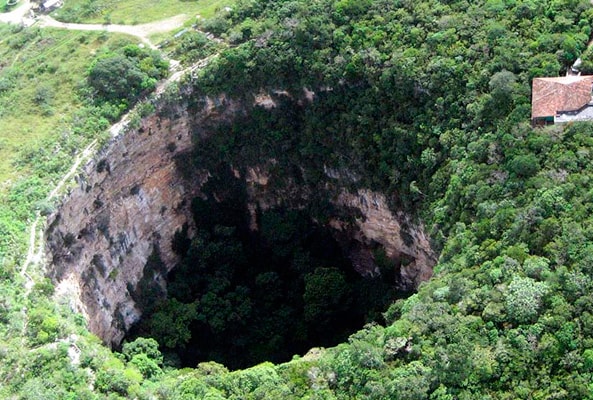
Located in Chiapas, Mexico, Sima de las Cotorras – meaning “Sinkhole of Parrots†– is an impressive 520-feet (160 meters) wide, 460-feet (140 meters) deep perforation in the landscape. It is well known for the myriad green parakeets that seek refuge in the trees at its base. Other birds and small animals – including hummingbirds, orioles, woodpeckers, coyotes, anteaters and iguanas – also live in the isolated forest at the bottom.
Like many other similar sinkholes in the area, Sima de las Cotorras was most likely formed out of the limestone rock by the gradual dissolving power of an underground river, such as the nearby RÃo La Venta. Another unique feature of this particular sinkhole is that 230 feet (70 meters) down from the rim there are 46 rock paintings, which experts believed were painted by ancestors of the native Zoque people as many as 10,000 years ago.
5.Bimmah Sinkhole – Muscat, Oman
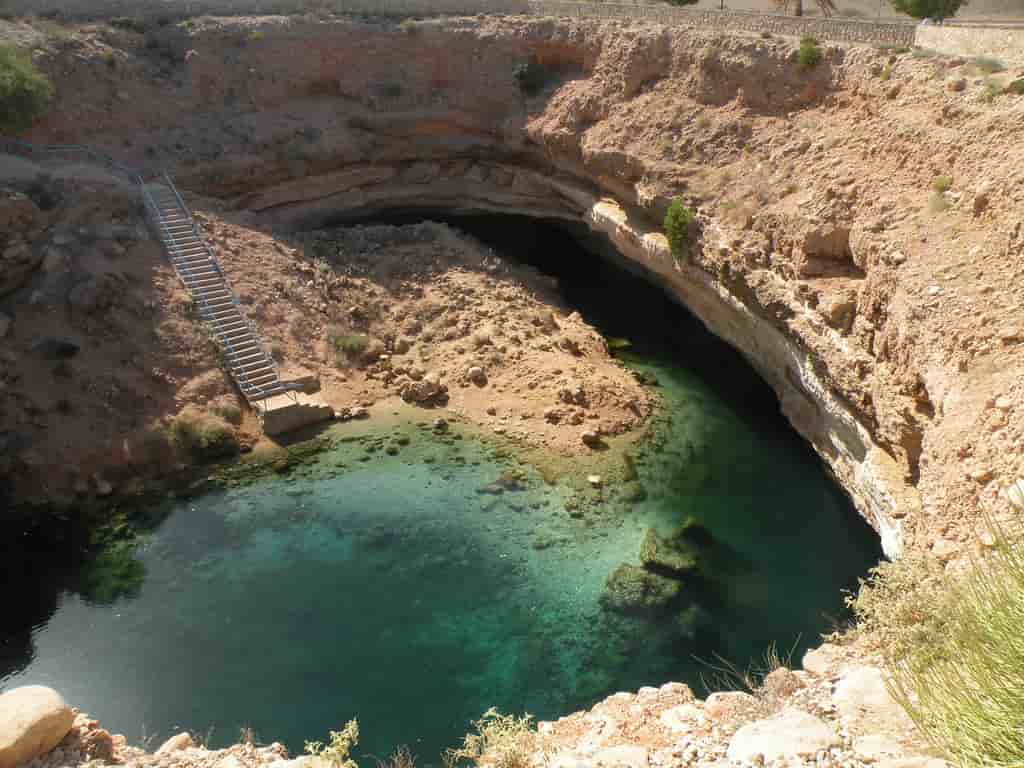
The Bimmah sinkhole is situated in Hawiyat Najm (“Meteor Fallâ€) Park in the region of Muscat in northern Oman. Gorgeous turquoise-colored water fills the 65-foot (20-meter) deep, 131-foot (40-meter) wide sinkhole, and an underwater tunnel links the hole to the sea – which may be the reason the water is such a mesmerizing shade of blue. The Bimmah sinkhole has become a popular tourist destination: some visitors enjoy swimming in the water watching hundreds of little fish dance about their toes, while others leap from the rim and land in the pool below with a splash. Although the sinkhole was formed by a natural process of limestone erosion and subsidence, local legends claim – more colorfully – that it was created by a falling meteor.
4.Guatemala City Sinkhole – Guatemala City, Guatemala
Not all sinkholes were formed in remote regions millennia ago. In recent times, some have opened up right in the middle of cities, swallowing houses, people and buildings. In 2010, the sinkhole pictured above collapsed in Guatemala City, Guatemala, sending a three-story building crashing almost 100 feet beneath the ground. Fortunately, no one was inside the structure when it disappeared. A similar sinkhole arose in the same city in 2007, resulting in the deaths of three people. The Guatemalan government spent $1.5 million filling in the 2007 sinkhole, but the area was deemed unfit to inhabit.
Although the exact cause of the 2010 sinkhole is unknown, it’s possible that a cavity already existed underground for many years. The roof of the cavity might have then been weakened by water – thanks to burst pipes, poor drainage or tropical storms – until it eventually collapsed, opening up the 60-foot (18-meter) wide hole in the city.
3.Cave of Swallows – San Luis PotosÃ, Mexico
Staying in Mexico, the Cave of Swallows, in the state of San Luis PotosÃ, is another limestone sinkhole – and a pretty special one at that. The sinkhole plummets to a depth of 1,214 feet (370 meters) from its highest to its lowest point. White-collared swifts, parakeets and conures (a species of green parrot) nest in the cave and fly out every morning, with the birds returning in the evening. Observing the avian creatures circling around the cave entrance and freefalling to their nests far below is a major attraction for tourists. BASE jumpers are also drawn to this huge vertical cave; these daredevils enjoy leaping off its rim before hurtling into the sprawling black void below.
2.Dean’s Blue Hole, The BahamasÂ
The world’s deepest known blue hole (underwater sinkhole) with seawater. It plunges 202 meters (663 ft) near Long Island, Bahamas. Dean’s Blue Hole is roughly circular at the surface, with a diameter ranging from 25 to 35 meters (82–115 ft). After descending 20 meters (66 ft), the hole widens considerably into a cavern with a diameter of 100 meters (330 ft). On 14 December 2010 , William Trubridge broke a free-diving world record in the blue hole – he swam to a depth of 101 meters on a single breath using only his hands and feet for propulsion!
1.Great Blue Hole – Lighthouse Reef, Belize
The magnificent Great Blue Hole lies 43 miles off the coast of Belize, close to the midpoint of the Lighthouse Reef atoll. This almost perfectly circular underwater sinkhole is 407 feet (124 meters) deep and more than 984 feet (300 meters) wide. It’s a stunning geographical wonder that stands out from the surrounding turquoise water like a black eye. The Great Blue Hole was actually formed above the ocean’s surface in the last ice age. As testimony to its origins, massive stalactites spring out of the limestone cavern, and together with stalagmites and unusual columns, they make the hole seem both otherworldly and beautiful.
This submarine sinkhole is a popular destination with divers, but due to its back-sloping walls, divers should be experienced and have very good buoyancy control to plumb its depths. And the deepness of the hole also makes decompression essential. Perhaps surprisingly, inside the Great Blue Hole there is not much marine life, although lone sharks are sometimes spotted.

